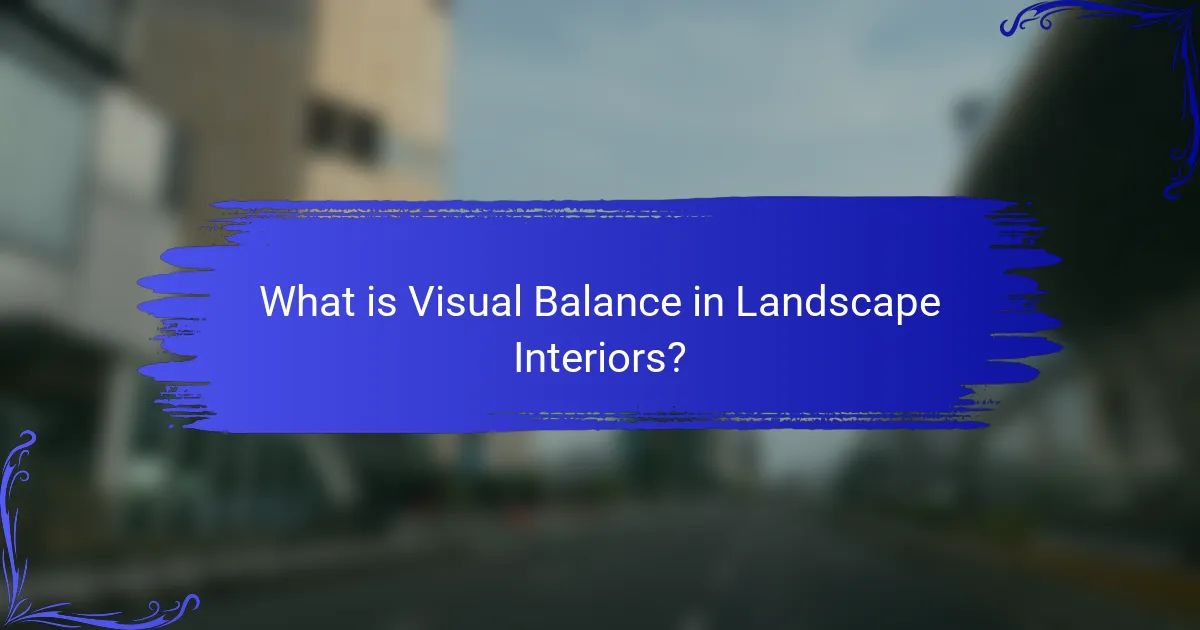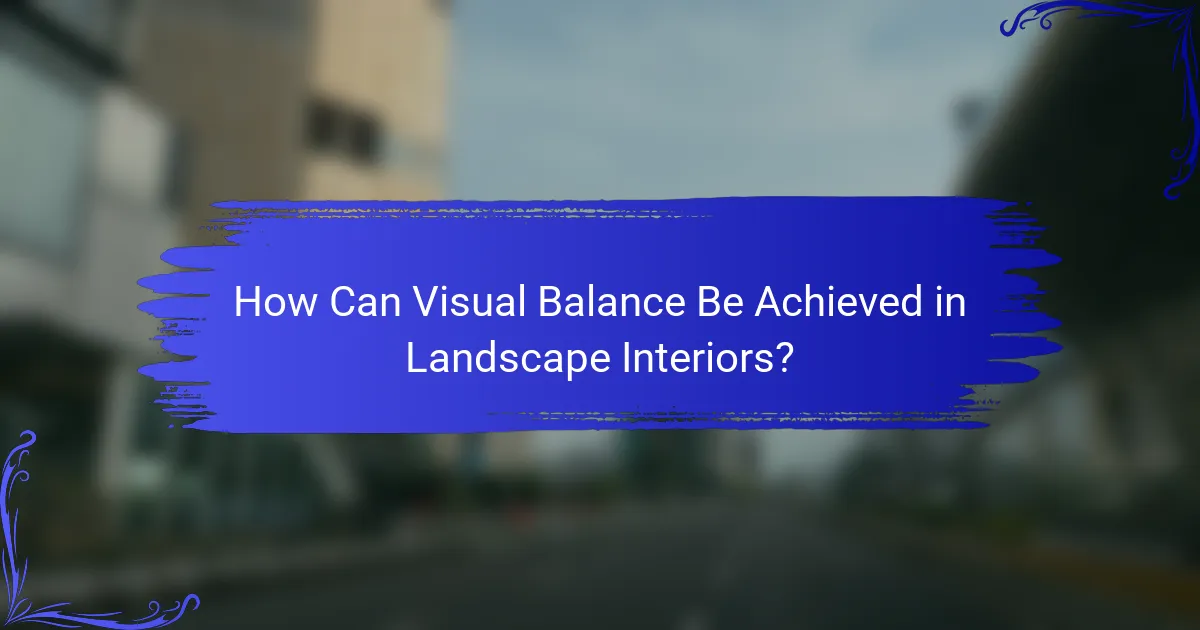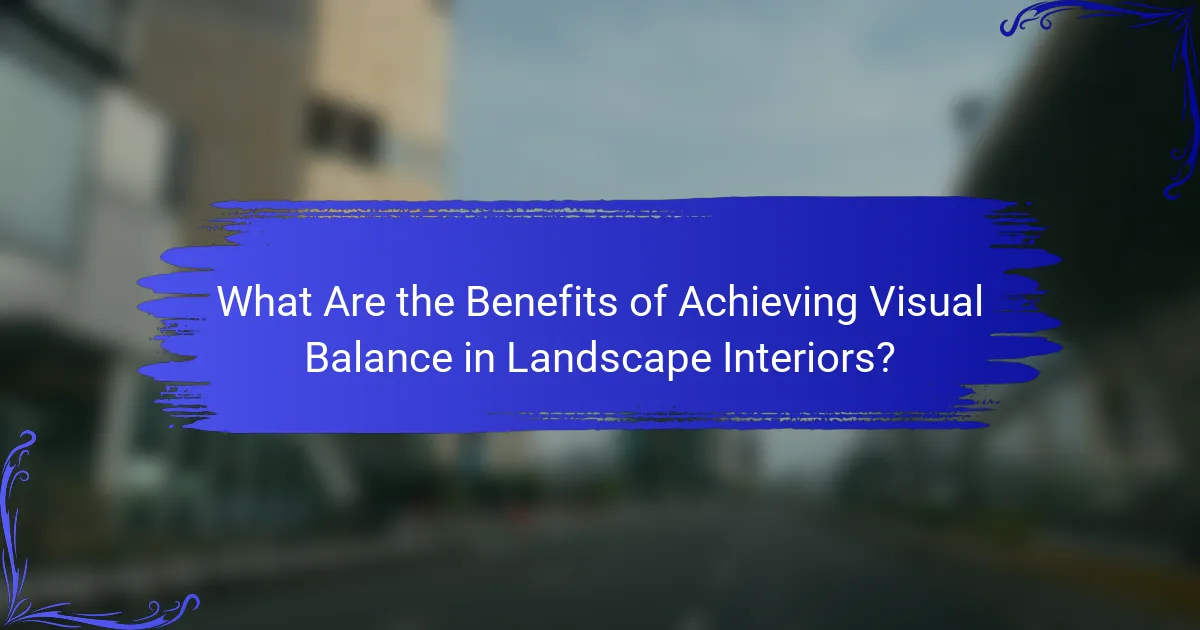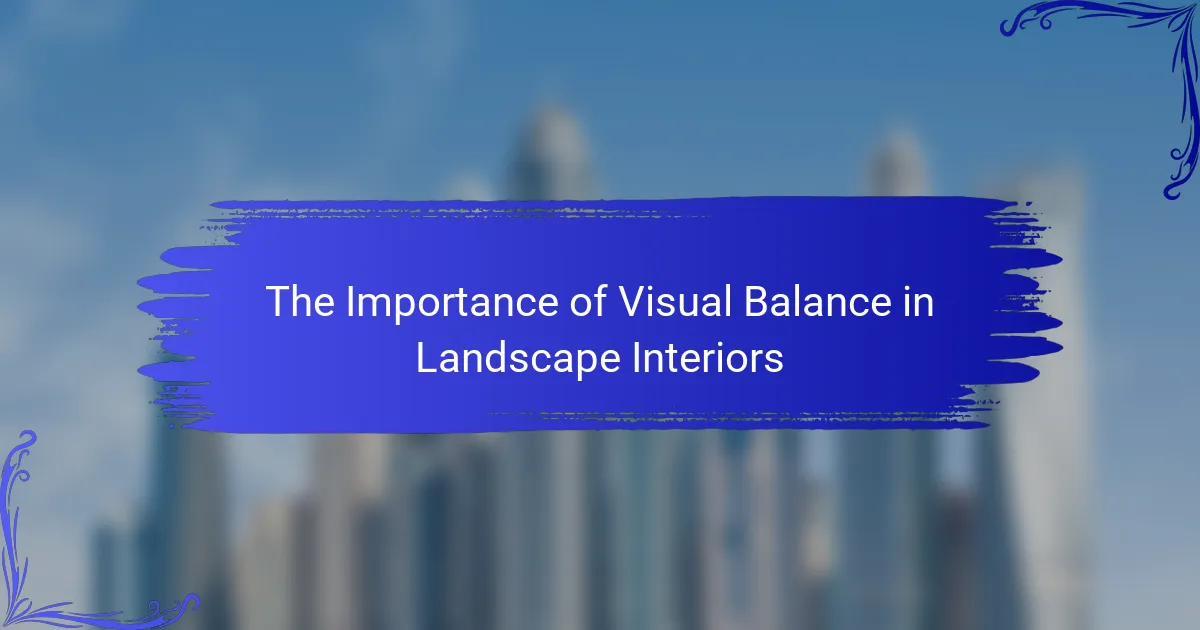Visual balance in landscape interiors refers to the harmonious distribution of visual weight among design elements, contributing to stability and aesthetic appeal. This article explores the different methods of achieving visual balance, including symmetrical, asymmetrical, and radial arrangements, each offering unique benefits. Key concepts such as the strategic placement of elements, the use of varying heights and textures, and the impact of color contrasts are examined to illustrate how they enhance the perception of balance. The significance of proportions in achieving a cohesive design is also discussed, emphasizing the positive effects of balanced landscapes on mood, well-being, and property value. Overall, the article highlights the essential role of visual balance in creating inviting and organized landscape interiors.

What is Visual Balance in Landscape Interiors?
Visual balance in landscape interiors refers to the harmonious distribution of visual weight within a space. It ensures that elements are arranged in a way that feels stable and aesthetically pleasing. This balance can be achieved through symmetry, asymmetry, or radial arrangements. Symmetrical balance involves mirroring elements on either side of a central axis. Asymmetrical balance uses different elements that have equal visual weight to create a cohesive look. Radial balance arranges elements around a central point, drawing the eye inward. Effective visual balance enhances the overall design, making spaces feel more inviting and organized.
Why is Visual Balance Important in Landscape Interiors?
Visual balance is crucial in landscape interiors because it creates harmony and coherence in design. This balance helps to guide the viewer’s eye across the space. It ensures that no single element overwhelms others, promoting a sense of peace. A well-balanced landscape can enhance the aesthetic appeal significantly. Studies show that balanced designs lead to increased satisfaction among occupants. Visual balance can be achieved through symmetry, proportion, and the strategic placement of elements. It also plays a role in functional aspects, such as accessibility and flow. Ultimately, visual balance contributes to a more enjoyable and usable landscape interior.
How does Visual Balance Affect the Overall Aesthetic?
Visual balance significantly enhances the overall aesthetic of landscape interiors. It creates a sense of harmony and order, making spaces more visually appealing. When elements are arranged to achieve balance, they draw the viewer’s eye and encourage exploration of the space. Studies show that balanced designs can evoke positive emotional responses. For instance, the Journal of Environmental Psychology states that balanced environments promote relaxation and well-being. This connection between visual balance and aesthetic appeal is essential for effective landscape interior design.
What Role Does Visual Balance Play in Functionality?
Visual balance enhances functionality by creating harmony in design. It ensures that elements are distributed evenly, leading to a cohesive look. This balance directs the viewer’s eye, making spaces more navigable. In landscape interiors, it affects how people interact with the environment. Studies show that balanced designs improve user comfort and satisfaction. For instance, a well-balanced garden layout allows for easier movement and accessibility. Overall, visual balance plays a critical role in optimizing both aesthetic appeal and practical use in landscape interiors.
What Are the Key Elements of Visual Balance in Landscape Interiors?
The key elements of visual balance in landscape interiors include symmetry, proportion, and focal points. Symmetry creates a sense of stability and order. It involves arranging elements in a mirrored fashion on either side of a central axis. Proportion refers to the size relationship between different elements. Proper proportion ensures that no single element overwhelms the space. Focal points draw attention and create interest within the design. They can be achieved through unique plant arrangements or decorative features. Additionally, color harmony contributes to visual balance. Complementary colors can enhance the aesthetic appeal and unify the space. Lastly, texture variation adds depth and intrigue, balancing visual weight across the landscape.
How Do Color and Texture Contribute to Visual Balance?
Color and texture significantly contribute to visual balance in landscape interiors. Color creates harmony or contrast, influencing the viewer’s perception. Warm colors can draw attention, while cool colors recede, affecting spatial relationships. Texture adds depth and tactile interest, enhancing visual engagement. Varied textures can break monotony and create focal points. Together, they establish equilibrium by balancing visual weight. Research indicates that effective color and texture use can enhance emotional responses in spaces. For instance, a study by Küller et al. (2006) found that color combinations directly impact mood and comfort levels in interior environments.
What Is the Impact of Scale and Proportion on Visual Balance?
Scale and proportion significantly impact visual balance in design. Scale refers to the size of elements in relation to each other and their environment. Proportion deals with the relationship between different parts of a whole. When elements are well-scaled and proportioned, they create harmony and stability. Conversely, poor scale and proportion can lead to visual discord. For example, a large object may overwhelm smaller elements, disrupting balance. Conversely, small objects can appear lost in a vast space. Research indicates that balanced proportions enhance aesthetic appeal and viewer satisfaction. This balance is crucial in landscape interiors for creating inviting and cohesive spaces.

How Can Visual Balance Be Achieved in Landscape Interiors?
Visual balance in landscape interiors can be achieved through strategic placement of elements. This includes using symmetry or asymmetry to create harmony. Symmetrical arrangements offer a sense of stability and order. Asymmetrical designs can provide dynamic interest while still maintaining balance.
Incorporating varying heights and textures helps to distribute visual weight evenly. Utilizing color contrasts can also enhance the perception of balance. For instance, placing darker elements next to lighter ones can create visual equilibrium.
Proportions play a crucial role in achieving balance. Elements should be scaled appropriately to their surroundings. A well-balanced landscape interior creates a cohesive and inviting atmosphere.
What Techniques Are Effective for Creating Visual Balance?
Effective techniques for creating visual balance include symmetry, asymmetry, and the use of focal points. Symmetry involves arranging elements evenly on either side of a central axis. This technique often evokes a sense of harmony and stability. Asymmetry, on the other hand, achieves balance through unequal distribution of elements. This method can create dynamic tension and interest in a design. Focal points draw attention to specific areas, guiding the viewer’s eye and creating a sense of order. Additionally, the use of color, texture, and scale can enhance visual balance. For instance, contrasting colors can balance each other, while similar textures can unify disparate elements. These techniques are supported by principles of design, which emphasize the importance of balance in visual composition.
How Can Symmetry and Asymmetry Be Used in Design?
Symmetry and asymmetry are essential principles in design that create visual balance. Symmetry involves mirroring elements on either side of a central axis. This technique fosters harmony and stability in a design. Asymmetry, on the other hand, involves a balanced arrangement of dissimilar elements. It can create a sense of movement and dynamism.
In landscape interiors, symmetry can be used to establish focal points. For instance, symmetrical plant arrangements can draw attention to a central feature. Asymmetrical designs can introduce variety and interest. They allow for creative expression while maintaining balance through careful positioning.
Research shows that symmetrical designs are often perceived as more attractive. A study published in the journal “Frontiers in Psychology” indicates that visual symmetry can enhance aesthetic appeal. Asymmetry can evoke emotional responses, making spaces feel more inviting. This balance between symmetry and asymmetry is crucial for effective landscape design.
What Role Do Focal Points Play in Establishing Balance?
Focal points play a crucial role in establishing balance in landscape interiors. They serve as visual anchors that guide the viewer’s eye. By creating a center of interest, focal points help to organize space and enhance composition. This organization leads to a harmonious arrangement of elements. For instance, a well-placed sculpture or plant can draw attention and create symmetry. This, in turn, balances surrounding features. Research in design principles supports that focal points enhance visual stability. Such principles are essential for effective landscape design.
What Common Mistakes Should Be Avoided When Pursuing Visual Balance?
Common mistakes to avoid when pursuing visual balance include overloading a space with too many elements. This can create visual clutter and disrupt harmony. Another mistake is neglecting scale and proportion. Objects that are not appropriately sized can throw off the balance. Failing to consider color harmony is also critical. Clashing colors can create tension rather than balance. Ignoring focal points is another issue. Every space should have a clear point of interest. Lastly, not accounting for symmetry and asymmetry can lead to imbalance. Properly integrating both can enhance visual appeal.
How Can Overcrowding Affect Visual Balance?
Overcrowding negatively impacts visual balance in landscape interiors. It creates a chaotic appearance that overwhelms the viewer. When too many elements compete for attention, harmony is lost. This can lead to confusion and discomfort in the space. Research shows that balanced design promotes relaxation and enjoyment. A study by Kaplan and Kaplan (1989) highlights that environments lacking balance can increase stress levels. Therefore, maintaining appropriate spacing and arrangement is crucial for visual balance.
What Are the Consequences of Ignoring Scale and Proportion?
Ignoring scale and proportion in landscape interiors leads to visual imbalance. This results in spaces that feel awkward or uncomfortable. For instance, large furniture in a small room can overwhelm the area. Conversely, small decor in a vast space can appear lost and insignificant. Poor scale and proportion disrupt the harmony of a design. This can diminish the overall aesthetic appeal of the landscape. Additionally, it may affect functionality, making areas less usable. Research shows that well-proportioned spaces enhance user experience and satisfaction.

What Are the Benefits of Achieving Visual Balance in Landscape Interiors?
Achieving visual balance in landscape interiors enhances aesthetic appeal and promotes a sense of harmony. It creates a cohesive environment that feels inviting and organized. Balanced landscapes can improve mood and well-being, making spaces more enjoyable for occupants. Studies show that well-balanced designs can reduce stress and anxiety levels. Additionally, visual balance can lead to increased property value, as appealing landscapes attract potential buyers. Properly balanced elements guide the eye and create focal points, enhancing overall design effectiveness. Ultimately, visual balance contributes significantly to the functionality and beauty of landscape interiors.
How Does Visual Balance Enhance User Experience?
Visual balance enhances user experience by creating a sense of harmony and stability in design. It allows users to navigate spaces more intuitively. Balanced layouts guide the viewer’s eye, reducing cognitive load. This leads to increased comfort and satisfaction. Research shows that balanced designs can improve user engagement by up to 20%. Effective visual balance also fosters emotional responses, making environments feel more welcoming. Overall, it significantly contributes to a positive interaction with the space.
What Psychological Effects Does Visual Balance Have on Occupants?
Visual balance positively influences the psychological state of occupants. It creates a sense of harmony and stability in a space. This sense of balance can reduce stress and anxiety levels. Studies show that balanced environments promote feelings of well-being. For example, a study published in the Journal of Environmental Psychology found that visual balance enhances mood and cognitive function. Occupants in well-balanced spaces report higher satisfaction. Additionally, visual balance can improve focus and productivity. This effect is particularly relevant in work and learning environments.
How Can Visual Balance Improve Property Value?
Visual balance can significantly improve property value by enhancing aesthetic appeal. A well-balanced landscape creates a harmonious environment that attracts potential buyers. Properties with visual balance often appear more inviting and well-maintained. According to a study by the National Association of Realtors, curb appeal can increase property value by up to 10%. This aesthetic enhancement encourages higher offers during sales. Additionally, balanced landscapes can contribute to better emotional responses from viewers. This emotional connection can lead to quicker sales and increased interest. Therefore, investing in visual balance is a strategic move for property owners aiming to boost value.
What Practical Tips Can Help in Achieving Visual Balance?
To achieve visual balance, distribute elements evenly across the space. Use symmetry to create harmony and stability. Incorporate contrasting colors to draw attention and maintain interest. Vary the size of objects to add depth and dimension. Utilize negative space to prevent overcrowding and enhance focus. Group similar items together to create a cohesive look. Consider the visual weight of each element; heavier items should be balanced with lighter ones. These strategies help create a visually appealing and harmonious landscape interior.
How Can One Assess and Adjust Visual Balance in Existing Spaces?
One can assess and adjust visual balance in existing spaces by evaluating the distribution of visual weight. Visual weight refers to how elements in a space attract attention. Start by identifying focal points within the area. Focal points can be artwork, furniture, or architectural features. Next, observe the arrangement of these elements. Ensure that no single area appears overly crowded or sparse.
To adjust visual balance, rearrange or add elements as needed. For instance, if one side of the room feels heavier, consider placing a larger item on the opposite side. Use colors and textures to create harmony. Lighter colors can make a space feel more open, while darker tones can add depth.
Incorporating symmetry can also enhance visual balance. Symmetrical arrangements often evoke a sense of order and stability. However, asymmetrical designs can create visual interest when balanced correctly.
Regularly stepping back to view the space as a whole aids in assessing balance. This perspective can reveal discrepancies that may not be obvious up close. Adjustments based on this evaluation can lead to a more aesthetically pleasing environment.
What Resources Are Available for Learning More About Visual Balance?
Books on visual balance include “The Art of Color” by Johannes Itten and “Design Basics” by David A. Lauer. Online courses are available on platforms like Coursera and Skillshare, focusing on design principles. Articles and tutorials on websites such as Smashing Magazine and Creative Bloq offer practical insights. YouTube channels dedicated to design, like The Futur, provide visual examples and explanations. Academic journals, such as the Journal of Interior Design, publish research on visual balance in interiors. Local workshops and community college courses often cover design fundamentals, including visual balance.
Visual balance in landscape interiors is the harmonious distribution of visual weight that enhances aesthetic appeal and functionality. This article covers the significance of visual balance, including its impact on user experience and psychological well-being, as well as practical techniques for achieving balance through symmetry, proportion, color, and texture. Key elements such as focal points and the consequences of poor balance are discussed, alongside strategies to assess and adjust existing spaces. The benefits of visual balance, including improved property value and occupant satisfaction, are also highlighted, providing a comprehensive understanding of its role in landscape design.
